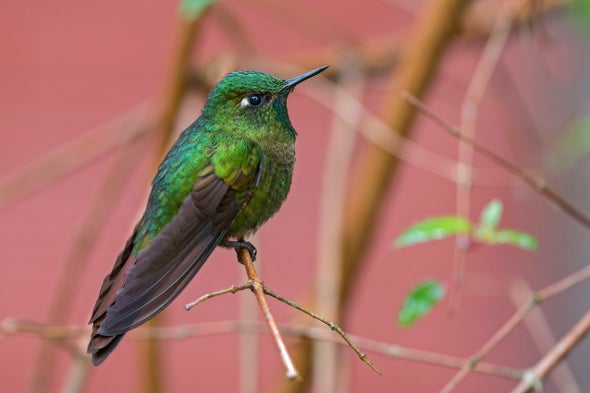(单词翻译:单击)
听力文本
This is Scientific American's 60-second Science, I'm Christopher Intagliata.
If a hummingbird has ever visited your garden, you've no doubt seen it flit from flower to flower, hovering midair as it sips on nectar. That activity requires plenty of energy. So hummingbirds need a lot of nectar to feed their hungry metabolisms.
"In fact, some of them probably drink two or three times their body mass in nectar each day."
Andrew McKechnie, an ornithologist at the University of Pretoria in South Africa.
McKechnie and his colleagues have studied hummingbirds at extreme elevations in the Peruvian Andes. To survive there, the tiny birds have developed a few tricks. For one, their blood cells are unusually efficient at transporting oxygen. Also, it's more difficult to hover in the high-altitude thin air. And so...
"The hummingbirds at those high elevations are much more prone to perching while they feed. So that does seem to be one way they try and reduce energy expenditure."

Now McKechnie and his colleagues have found another energy-saving adaptation: the high-mountain hummingbirds can lower their body temperature by extreme amounts at night—going into a state called torpor.
"I mean, for all intents and appearances, they're essentially dead. They're that unresponsive."
The scientists caught six species of Andean hummingbirds and monitored their temperatures through the night and day. And they found that all six species could enter some type of torpor—they lower their body temperatures from about 100 degrees Fahrenheit by day to as low as 38 degrees Fahrenheit at night. And being "essentially dead" conserves energy.
The details are in the journal Biology Letters.
Although some of the birds' low body temperatures are on par with those of hibernating mammals, it's important to note that this isn't full-fledged hibernation—which is a longer-term response. True hibernation has only ever been documented in one bird, so far at least: the common poorwill in the U.S. Southwest.
"One of my career goals is to find a second hibernating bird."
And the Andes, he says, is going to be the first place he looks.
Thanks for listening for Scientific American's 60-second Science. I'm Christopher Intagliata.
参考译文
这里是科学美国人——60秒科学系列,我是克里斯托弗·因塔格里塔。
如果蜂鸟曾造访过你的花园,你肯定会看到它在花丛间飞来飞去,啜饮花蜜时在半空悬停。这项活动需要大量能量。因此蜂鸟需要很多花蜜来满足饥饿的新陈代谢。
“事实上,有些蜂鸟可能每天喝两到三倍于自身体重的花蜜。”
南非比勒陀利亚大学的鸟类学家安德鲁·麦凯尼说到。
麦凯尼和同事研究了秘鲁安第斯山脉极端海拔地区的蜂鸟。为了在那里生存,这些小鸟进化出了一些技巧。首先,它们的血细胞在运送氧气方面异常高效。而且,在高海拔稀薄的空气中悬停更困难。因此……
“这些高海拔地区的蜂鸟在觅食时栖息的可能要高出很多。这似乎是它们试图减少能源消耗的一种方式。”
现在,麦凯尼和同事发现了另一种节能的适应表现:高山蜂鸟可以在夜间将体温极大地降低,进入一种被称为“麻木”的状态。
“从所有的意图和表象上看,它们基本上已经死了。它们就是这样毫无反应。”
科学家捕获了六种安第斯蜂鸟,并昼夜监测它们的温度。他们发现这六种蜂鸟都会进入某种“麻木”状态——它们会将体温从白天的约100华氏度降低到晚上的38华氏度。而“本质上死亡”可以保存能量。
研究详情刊登在《生物学快报》期刊上。
虽然一些鸟的低体温与冬眠哺乳动物的相当,但重要的是要注意,这并不是完全冬眠——这是一种更长期的反应。至少到目前为止,只有一种鸟类有过真正冬眠的记录:美国西南部的北美小夜鹰。
“我的职业目标之一是找到第二种冬眠鸟。”
他表示,安第斯山脉将是他第一个去寻找的地方。
谢谢大家收听科学美国人——60秒科学。我是克里斯托弗·因塔利亚塔。
译文为可可英语翻译,未经授权请勿转载!
重点讲解
重点讲解:
1. no doubt 无疑地;必定;
There is no doubt at all that we did the right thing.
毫无疑问我们做得对。
2. be prone to 有(不好的)倾向的;易于…的;很可能…的;
Old people's bones are more prone to fracture.
老人更易骨折。
3. on par with 与…同样;与…相似;
I used to be able to brag that Berlin was really affordable but now my rent actually works out on par with Washington and New York.
我以前到处宣扬柏林是个物价低廉的城市,不过现在我的房租几乎和华盛顿和纽约持平了。
4. so far 迄今为止;到目前为止;
He has a spotless record so far.
他的操行记录至今无任何污点。
关注微信公众号【可可双语精读】,获取详细讲解内容


